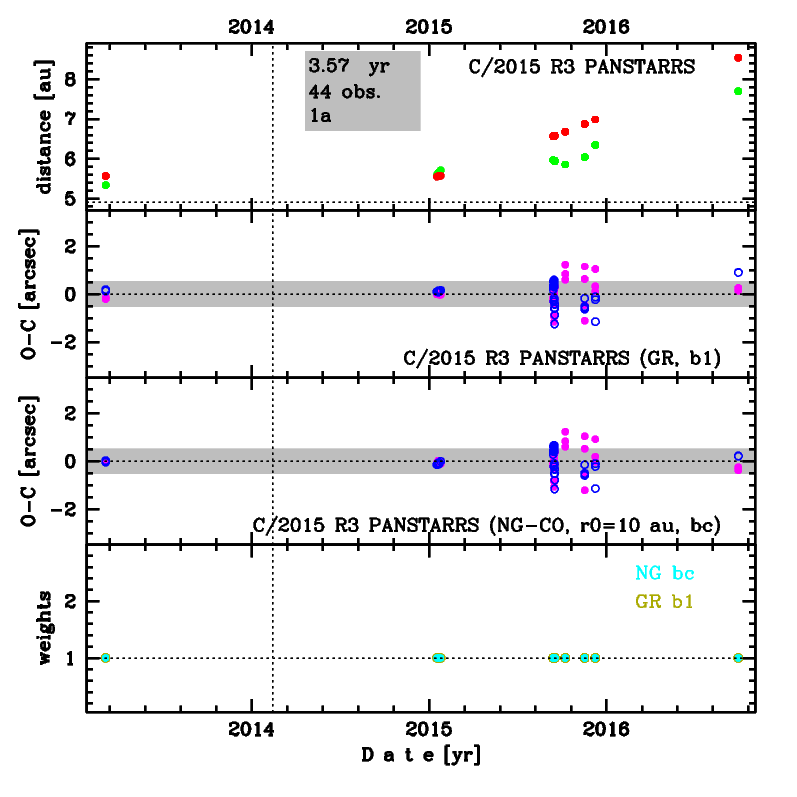C/2015 R3 PANSTARRS
more info
Comet C/2015 R3 was discovered on 12 September 2015 with Pan-STARRS 1 telescope (Haleakala), that is about 1.6 yr after its perihelion passage. After some time pre-discovery data were found going back to 5 March 2013. This comet was rarely observed until 28 September 2016.
Comet had its closest approach to the Earth on 8 May 2015 (4.939 au), a week after its perihelion passage.
We recommended GR solution spanning over 3.57 yr in a range of heliocentric distances from 5.57 au – 4.90 au (perihelion) – 8.54 au as the preferred orbit( solution 'b1'), because radial component of NG~acceleration is negative in solution 'bc'.
This Oort spike comet suffers small planetary perturbations during its passage through the planetary system that lead to a more tight future orbit with a semimajor axis larger than 10000 au (see future barycentric orbits).
Comet had its closest approach to the Earth on 8 May 2015 (4.939 au), a week after its perihelion passage.
We recommended GR solution spanning over 3.57 yr in a range of heliocentric distances from 5.57 au – 4.90 au (perihelion) – 8.54 au as the preferred orbit( solution 'b1'), because radial component of NG~acceleration is negative in solution 'bc'.
This Oort spike comet suffers small planetary perturbations during its passage through the planetary system that lead to a more tight future orbit with a semimajor axis larger than 10000 au (see future barycentric orbits).
| solution description | ||
|---|---|---|
| number of observations | 44 | |
| data interval | 2013 03 05 – 2016 09 28 | |
| data type | perihelion within the observation arc (FULL) | |
| data arc selection | entire data set (STD) | |
| range of heliocentric distances | 5.57 au – 4.90 au (perihelion) – 8.54 au | |
| detectability of NG effects in the comet's motion | comet with determinable NG~orbit | |
| type of model of motion | GR - gravitational orbit | |
| data weighting | NO | |
| number of residuals | 83 | |
| RMS [arcseconds] | 0.54 | |
| orbit quality class | 1a | |
| next orbit statistics, both Galactic and stellar perturbations were taken into account | ||
|---|---|---|
| no. of returning VCs in the swarm | 5001 | * |
| no. of escaping VCs in the swarm | 0 | |
| no. of hyperbolas among escaping VCs in the swarm | 0 | |
| next reciprocal semi-major axis [10-6 au-1] | 207.71 – 213.11 – 218.56 | |
| next perihelion distance [au] | 4.8859 – 4.8876 – 4.8891 | |
| next aphelion distance [103 au] | 9.15 – 9.38 – 9.62 | |
| time interval to next perihelion [Myr] | 0.309 – 0.321 – 0.334 | |
| percentage of VCs with qnext < 10 | 100 | |

Upper panel: Time distribution of positional observations with corresponding heliocentric (red curve) and geocentric (green curve) distance at which they were taken. The horizontal dotted line shows the perihelion distance for a given comet whereas vertical dotted line — the moment of perihelion passage.
Middle panel(s): O-C diagram for a given solution (sometimes in comparison to another solution available in CODE), where residuals in right ascension are shown using magenta dots and in declination by blue open circles.
Lowest panel: Relative weights for a given data set(s).
Middle panel(s): O-C diagram for a given solution (sometimes in comparison to another solution available in CODE), where residuals in right ascension are shown using magenta dots and in declination by blue open circles.
Lowest panel: Relative weights for a given data set(s).
| next_g orbit statistics, here only the Galactic tide has been included | ||
|---|---|---|
| no. of returning VCs in the swarm | 5001 | * |
| no. of escaping VCs in the swarm | 0 | |
| no. of hyperbolas among escaping VCs in the swarm | 0 | |
| next reciprocal semi-major axis [10-6 au-1] | 207.71 – 213.11 – 218.56 | |
| next perihelion distance [au] | 4.8806 – 4.8823 – 4.8839 | |
| next aphelion distance [103 au] | 9.15 – 9.38 – 9.62 | |
| time interval to next perihelion [Myr] | 0.309 – 0.321 – 0.334 | |
| percentage of VCs with qnext < 10 | 100 | |